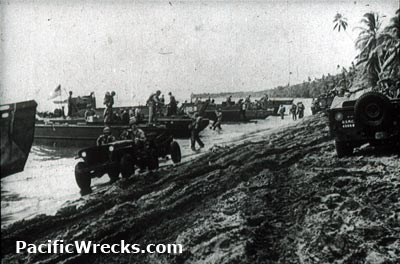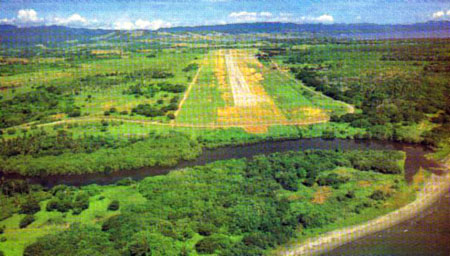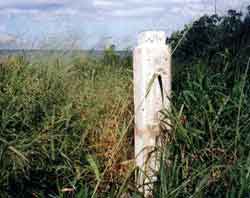Commentary by Justin Taylan
Robert Leckie
The series begins with Robert Leckie. Born in Philadelphia, Pennsylvania, he grew up in Rutherford, New Jersey. Prior to the war, he was a sports writer for a newspaper. On December 8, 1941, after the attack on Pearl Harbor, Leckie enlisted in the Marine Corps. The series is based on his memoir Helmet For My Pillow originally published in 1957.
John Basilone
Next, "Chesty" Puller briefing the 7th Marines about the war situation in the Pacific with Sgt John Basilone in attendance. Afterwards, Basilone spends the holidays with his family in Raritan, New Jersey.
Eugene Sledge
Young Eugene Sledge and his family in Mobile, Alabama are introduced next. His father, a doctor diagnosed him with a heart murmur and forbid him from joining the military. The series is also based on Sledge's memoir With The Old Breed originally published in 1981.
Sidney "Sid" Phillips
Sledge bikes to meet his friend "Sid" Phillips, who is enlisting in the Marine Corps. Philips is one of the only primary characters who is still alive today. He is interviewed at the start of this episode. Phillips was also interviewed in the Ken Burns series, The War. To learn more about him, visit Marine Sid Phillips and read his memoir You'll Be Sor-ree!
Landing at "Red Beach" on Guadalcanal
On August 7, 1942 the Marines land on Guadalcanal at Red Beach without resistance. They are incorrectly shown landing in LCVP landing craft. In fact, the initial Marine landing was made in Higgins boats. "The Pacific" was filmed in Australia, not on location at Guadalcanal. The only Hollywood movie that includes scenes shot on Guadalcanal was The Thin Red Line (1999).
The Airfield
Next, the Marines are shown at the edge of the Japanese built Lunga Point Airfield, the focal point of the entire Guadalcanal campaign. The Japanese 'Hama Construction Unit' began work on the airfield July 9 and worked proceeded quickly. By August 6 the airfield was ready and all were given extra sakai rations for completing their work ahead of schedule.
This airfield would allow Japanese land based aircraft to patrol the shipping
lanes to Australia and
the eastern
flank of New Guinea. The Marine landing caught them by surprise, and the Japanese fled into the jungle leaving stockpiles of rice, liquor, radio equipment and even a radar set! The airfield was renamed "Henderson Field" in honor of Major Lofton Henderson. Today, it is still in use as "Honiara International Airport".
The Battle of Savo Island
The episode shows Marines watching a night Naval battle in the distance. The Battle of Savo Island August 8-9, 1942 was the first of many Naval engagements off Guadalcanal. The outcome was the loss of four Allied cruisers and 1,077 sailors. The Japanese only suffered three cruisers damaged, but withdrew before dawn and failed to exploit their victory further. This defeat caused the Allied warships and transports to withdrew, leaving the Marines without support.
Alligator Creek
Marines are shown digging into positions east of the airfield along a riverbank, nicknamed "Alligator Creek". This was a misnomer because no alligators inhabit Guadalcanal, only crocodiles. In fact, it feature was the Ilu River, but was also incorrectly called the Tenaru River.
During the night of August 21, this location was the site of the Battle of the Tenaru (Ilu River, Alligator Creek) when the Japanese Army's "Ichiki Regiment" attacked in three waves. Their commander, Colonel Ichiki underestimated the Marines and failed to perform any reconnaissance about their positions, and the attack failed. During the battle, Ichiki was killed by mortar fire.
An LVT Amtrak
landing craft is shown abandoned on the eastern bank of the river. Mortarman "Sid" Phillips wrote in You'll Be Sor-ree! "Lt. Pollack directed us to fire on an abandoned Marine amphibian tank on which the Japs had set up a machine gun on the other side of the river. We corrected range in a couple of rounds and then put one right in the tank. A loud cheer went up like a touchdown at a football stadium."
During the later phase of the American occupation of Guadalcanal, the island was developed into a major staging base and airfield complex used for the duration of the war. Today, a dump area for LVT Amtraks are abandoned at Tetere, but these were used for training exercises, not combat during 1942.
Dawn after the battle is accurately portrayed as Marines inspected dead Japanese on the beach. Several famous photographs of these bodies make the dead appear to be asleep on the sand. Absent from the episode are the morning actions when the surviving Japanese were compressed into a small area in a coconut grove east of the river. Five Marine M3 Stuart tanks attacked the survivors, firing their machine guns and 37mm canister shot then rolling over the Japanese, both alive and dead. Marine General Vandegrift candidly wrote "the rear of the tanks looked like meat grinders".
Today there are few traces of the battle, and even the tall coconut palms have long since been removed. After the battle, this area was developed into a camp and dump area, erasing the original Marine positions. The remains of the Japanese on the sandbar were exhumed during the 1980s and their ashes returned to Japan. Only a simple Japanese and American memorial post mark the battlefield area today.
Souvenir Hunters
Leckie is seen holding a small mascot doll and sorting through photographs found on the dead Japanese soldier, then burning the souvenirs on a fire.
Although not portrayed in the episode, Helmet For My Pillow, describes one Marine nicknamed "souvenirs" who was removing the gold teeth from fallen Japanese soldiers. Leckie himself writes about swimming across the river to steal a pair of binoculars from a dead body. Back ashore, he and his friends use the same binoculars to watch a large crocodile devouring the same corpse.
Commentary by author and historian William Bartsch:
"If everyone can hang in there for about a year, my detailed account of the Battle of the Tenaru, Victory Fever at the Tenaru should be out, based on the accounts of participants in the 2nd Battalion, 1st Marines (and also the 1st Battalion for the clean-up operation, with the tanks) and the 1st Special Weapons Battalion with their 37 mm anti-tank guns and machine guns. And let's not forget the 11th Marines firing their 75 mm pack howitzers that night and following morning.
Overall, Episode 1 of "The Pacific" was spectacular in its filming and fairly accurate for this initial period on Guadalcanal. Some inaccuracies hit me, though:
1) The Marines (Leckie's and Phillips' battalion, for instance) came ashore from Higgins boats, not the ramped LCVP landing craft depicted in the film. The men had to jump over the side on the Higgins boats, not walk off the ramp as shown. Couldn't the producers have made some Higgins boats instead of those ramp boats?
2) No Marine had been killed and mutilated by Japanese in those first days, as shown. Such incidents came later in the Guadalcanal campaign.
3) The first two days, the battalions of the 1st Marines were basically lost as they marched through the jungle towards Mount Austen. This doesn't come out sufficiently in the film.
4) The .30 Browning machine guns were dug in on the west bank of the Tenaru (Alligator Creek), with logs covering their positions, not out in the open as shown in the film. And where are the 37 mm anti-tank guns that fired canister with devastating effect into the Japanese trying to cross the sand spit during the Battle of the Tenaru.
5) Contrary to what is shown, it was not Leckie and Juergens who were firing into the hordes of Japanese crossing the spit that night, but rather Albert Schmid, Corporal Leroy Diamond and Pfc John Rivers, who got no coverage here for some strange reason. Leckie wrote that he was to their right (after shifting down from the beach defense) and does not claim any major role in the firing that night. I also wonder how (in his book) he and Juergens alone shifted their machine gun and tripod from their initial position without any ammunition carried with them! A machine gun squad comprised more than two men, but Leckie mentions only Juergens."
Return to historical commentary main page |

Robert Leckie

Sgt John Basilone

Eugene Sledge

Sid Phillips signing You'll Be Sor-ree!

Marines in Higgins boats landing at "Red Beach" August 7, 1942

Lunga Point Airfield August 7, 1942

Aerial view of Tenaru River (Ilu, Alligator) and Henderson Field

USS Quincy caught in searchlights during the Battle of Savo Island
August 9, 1942

LVT Amtrack dump at Tetere, Guadalcanal

Japanese dead on the sandbar after Battle of Tenaru August 22, 1942

Japanese dead on the sandbar after Battle of Tenaru August 22, 1942

Japanese dead after Battle of Tenaru
August 22, 1942

Ilu River sandbar today

US Memorial at Tenaru (Ilu River, Alligator Creek) at position manned by Al Schmid
|